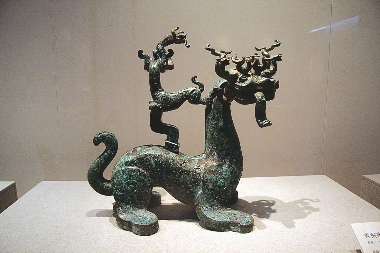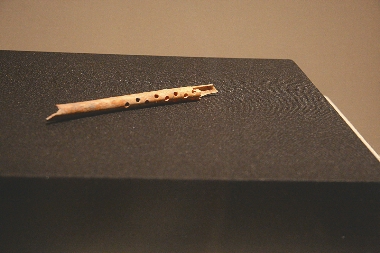




Helen Deng
A FLUTE that was played in what is now Henan Province some 8,700 years ago is being exhibited at the Shenzhen Museum of History and Folk Culture.
The flute, carved from the hollow wing bones of red-crowned cranes, is the world’s oldest complete and multi-tonal musical instrument. It is still playable, according to Li Hong, director of Huaxia Ancient Music Ensemble at Henan Museum.
“Similar flutes did not appear in Greece until more than 1,000 years later,” said Li, at a press conference on the “Ancient Chinese Music Relics Exhibition” last week.
The exhibition displays 61 sets of Chinese music relics that appeared on the Central Plain, or today’s Henan Province, during the past 9,000 years. The exhibition presents a paramount view of the history of Chinese music.
The exhibition is composed of five parts: “Music in the Prehistorical Period,” “Music in the Xia, Shang and Zhou Dynasties (2100-221 B.C.),” “Music in the Han and Wei Dynasties (206 B.C.-A.D. 265),” “Music in the Sui and Tang Dynasties (581-907),” and “Music From the Song to Qing Dynasties (960-1911).”
“Music in the Prehistorical Period” features simple pottery music instruments such as pottery drums. Exhibits in this part show the origin of Chinese music as recorded in legends.
“Music in the Xia, Shang and Zhou Dynasties” features exquisite musical instruments that were used by aristocratic families and at the imperial courts. The most precious relic is a bronze beast that was used to support drums. The animal has a dragon’s head, a tiger’s body, and a tortoise’s feet. Its horns are formed by six small dragons, and a dragon-like beast stands on its back. The whole body is decorated with patterns of dragons and phoenixes formed by malachite. Exhibits also include a set of bronze chimes that were played for grand ceremonies.
During the Han and Wei dynasties, the ceremonial music was gradually replaced by entertaining music accompanied by dancing. This is shown through the sculptures, carvings and paintings of dancing artists at the exhibition.
The Tang and Sui dynasties saw the integration of singing, music playing, and dancing into large-scale performances. Sculptures of musicians and dancing artists show the popularity of dancing and music at the time.
After the Song Dynasty, music was no longer the sole preserve of aristocrats. It entered common households and thus gave rise to the popularity of opera and drama. Brick carvings, unearthed from tombs and with artists performing operas and people watching shows, give a glimpse to what life was like during the period.
All the exhibits were unearthed from the Central Plain, which is widely regarded as the birthplace as well as the center of Chinese civilization.
The exhibition is jointly held by Henan Museum and Shenzhen Museum.
Shenzhen Public Art Center celebrates 20th anniversary
|

